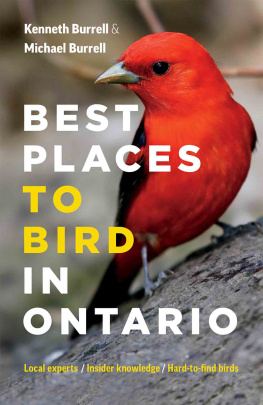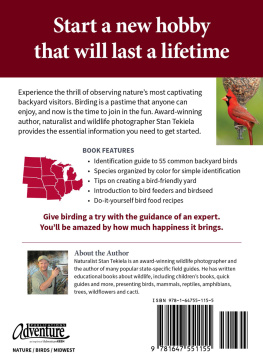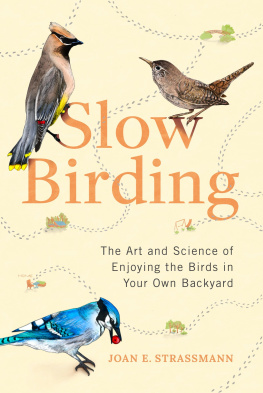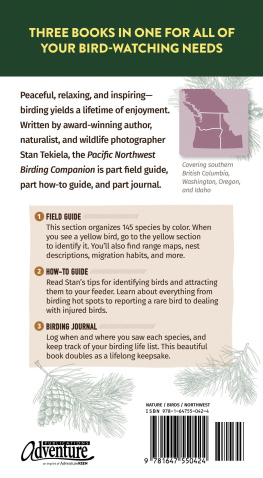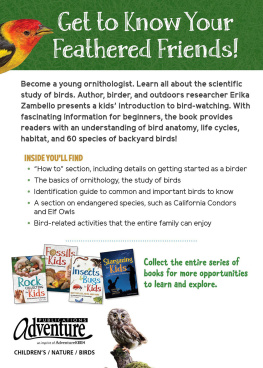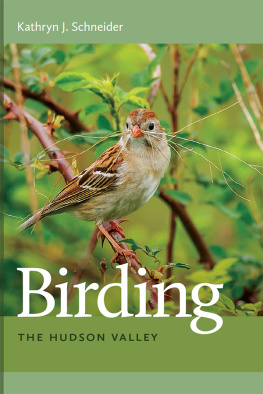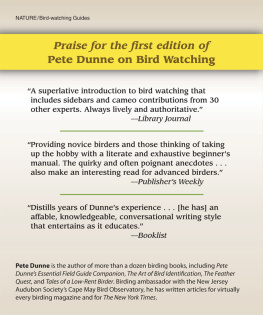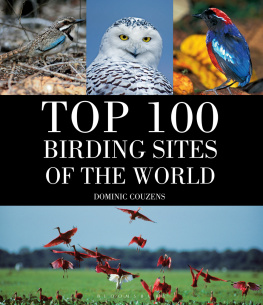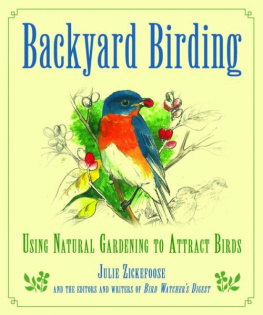
Easily one of the most charming species in Ontario is the Yellow Warblerits arrival in spring always signals that the other warblers arent too far behind. MICHAEL BURRELL

To our parents
Without your ever-present encouragement and willingness to support us (not to mention driving us around to all of these sites as kids!), this book would not have been possible.

CONTENTS
INTRODUCTION
LOCATED ALONG BOTH the Atlantic and Mississippi flyways, Ontario is a birding mecca. Its diverse geography allows birders to explore the Great Lakes, the Arctic coastlines of James and Hudson Bays, expansive boreal forests, and a taste of southern Carolinian forests. The province has one of the most active birding communities on the continent and a species list approaching 500, so its no wonder so many birders enjoy Ontario in all of its seasons.
Our own interest in birds took off one spring when our parentswho are avid birdersdrove us down to Long Point to drop off a few dozen Prothonotary Warbler nest boxes. We were pre-teens at the time, and as we met the wonderful people of Bird Studies Canada, attended the Doug Tarry Young Ornithologists Workshop, and realized how lucky we were to live in such an ecologically and ornithologically rich region, we also became aware that birding was an actual career path we could pursue. Since then, both of us have been absolutely obsessed with birds and weve spent most of our free time learning and chasing birds from one corner of the province to the next.
Both of us had talked about sharing our knowledge of Ontario birds in book form at some point, so when the opportunity presented itself, we knew we couldnt pass it upeven knowing we were in for some late nights of pulling together all the bits of knowledge we had gained over two decades of birding.
We knew that we wanted to make this book different from Clive Goodwins A Bird-Finding Guide to Ontario, published in 1995. And it soon became apparent that it would be a fair bit different, primarily in that it covers our favourite sites in more depth, including updated information on the sites and birds themselves, birding strategies, and natural and cultural history sprinkled with some personal stories.
At first, formulating a list of the top 30 places to bird in the province sounds easy, but we quickly found that isnt the case. We didnt apply a rigorous scientific method to the task; rather, each of us started with our top five areas to bird, and from there we added other favourites. Making the list was easy; whittling it down to 30 was not! The list of top birding destinations in Ontario is extensive.
In making our final selection, we tried to find a balance of locations across the province and in different ecological zones. We also took into account where most of our readers would be, considering both visiting birders and birders who live in the province, which is why we have included many areas within a couple of hours of the Greater Toronto Area (GTA). Ultimately, we are happy with the sites we have chosen, but we know that not everyone will agree with our choices. We just didnt have space for some of the other excellent birding spots, including the Hudson Bay coastline, Haldimand County, the upper Bruce, Manitoulin Island, the north shore of Lake Superior, and Luther Marsh, to name a few.
You may also notice some personal biases in the book, notably that the Kingston and Pelee areas are thoroughly covered. Mike lived for two years in Kingston, and Ken spent entire springs down at Pelee doing research for his masters thesis, which means we have lots of in-depth knowledge that we really felt we should share. In every chapter, we have tried to provide detailed information that will be useful for birders of all skill levels, whether living in the area or travelling through. Included for each location is a site overview, a birding guide to the area with helpful tips, and directions to get there.
FINDING THE BIRDS
If you havent joined eBird (ebird.ca), do so before you set out. eBird provides birders around the world with a host of information, such as latest sightings and interactive range maps, and in Ontario a large proportion of birders use it to log their sightings. As such, via eBird you have access to up-to-date information about what birds are being seen and where.
The Ontario Field Ornithologists (OFO) (ofo.ca) is the leading organization for birders in the province. The OFO organizes field trips throughout the year all over the province; runs the Ontbirds listserv, which disseminates information about rare bird sightings in Ontario; and produces an excellent newsletter (OFO News) and journal (Ontario Birds) tailored to birding in the province (both published three times a year). We feel strongly that all Ontario birders should be members.
BIRDING ETHICS
Anyone who spends their time searching out birds is bound to also want to protect them and preserve their habitat. The OFO has a code of ethics for all those who observe or photograph birds, and we feel strongly that the following principles from the code are most noteworthy:
Keep disturbance to a minimum.
Always assume that a bird is sensitive to your presence. Although some birds can tolerate human activity, this varies from species to species and from season to season.
To avoid stressing birds or exposing birds to danger, exercise restraint during observation, photography, sound recording, or filming.
Do not deliberately flush birds.
Limit the use of [audio] playbacks or other methods of attracting birds. Never use such methods in heavily birded areas, or for attracting any species that is Endangered, Threatened, or of Special Concern, or is rare in your local area.
Do not trespass. Always obtain permission to enter sites that are posted.
We cant stress whats stated above enough, particularly when viewing rare or at-risk species and owls.
BIRDING IN ONTARIO
For birders visiting Ontario, there are a few things to be aware of when out and about.
Ticks. Ticks carrying Lyme disease are now fairly regular in much of southern Ontario, so taking precautions such as tucking your pants into your socks and doing daily tick checks is a good idea. Mosquitoes and other biting flies (black flies and deer flies, mainly) can also be a major irritant; mosquitoes generally peak in June, black flies in late May, and deer flies in July. When visiting any wooded habitats in June, youll likely want to wear a long-sleeved shirt and bring bug spray.
Seasonal weather. If youre birding in spring or fall migration, youll want to pay close attention to the weather. In spring migration, birds typically arrive following a warm front with winds from the south that bring the warmer temperatures. Conversely, in fall, birds arrive following a cold front with winds from the north that bring the cooler temperatures. In both cases, if you can get these conditions at night interrupted by inclement weather (e.g., rain, high winds, thunder/lightning), you have the right conditions for a large grounding or fallout of birds. As such, the best days for birding at these times of year often involve some precipitation.

